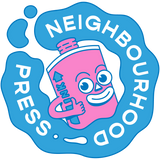-

The Japanese-made Risograph printer started life in the 1980s as a speedy, high-volume duplicator for schools and offices.
But in recent years, it’s had a bit of a glow-up. These once-humble machines have landed in the hands of artists and printmakers, who quickly fell in love with the Riso’s quirky charm and clever tech. With its knack for layering punchy, vivid colours, the Risograph has gone from boring office gear to art studio hero—bringing bold, joyful prints to life, one colour at a time.
-

So, how does it actually work? The Risograph is kind of like a magical stencil machine from the '80s.
First, it makes a stencil of your artwork and wraps it around a big ink-filled drum (think: high-speed printing burrito). The drum spins super fast, pushing ink through the stencil and onto the paper—voilà, your first colour is printed!
Want more colours? Time to swap out the drum for a new one with different ink, make a new stencil, and run the paper through again. Each layer stacks on top of the last, creating those beautifully bold, slightly wonky prints that make Risograph so loveable.
-

The Risograph has its own special set of colours—and we’re lucky enough to have twelve dreamy inks to play with, from rich deep hues to eye-popping fluorescents.
All Riso inks are semi-transparent, which means they can be layered on top of each other in a process called overprinting. That’s where the real magic happens: mix two colours and boom—a third one appears. Think fluorescent pink printed over blue to create an electric purple. It’s colour-mixing meets happy accident (with very cool results).
-

Risograph machines are unique in the way they combine digital methods with the best of hands on print techniques.
Our trusty printers—Ziggy and Katsumoto are RP3700 single drum superstars, printing one colour at a time. That means the process is a bit more involved (and way more fun), with plenty of room for experimentation.
Riso printing isn’t always neat and tidy—there can be little quirks like slight misalignments, roller marks, or grainy textures but that’s all part of the charm. Every print comes out with its own personality, and no two are ever exactly the same. It’s all those tiny imperfections that make Risograph prints so wonderfully unique.
-

Risograph printing doesn’t just look amazing—it’s also one of the most planet-friendly ways to print.
Riso machines were designed with sustainability in mind. They use a heat-free process and print with non-toxic, plant-based inks, which means they use very little power and skip all the nasty pollutants you’d find in regular digital or toner-based printing.
Our inks are made from rice bran oil—a clever, earth-loving alternative to the petroleum-based inks most of the print world still uses. They’re non-toxic, free from nasties, and can even be composted or recycled.
Got questions or want the nitty-gritty on the Riso’s eco credentials? We’d love to chat—just get in touch!
-

At Neighbourhood Press, we’re all about Risograph printing because it lets us bring our designs to life in the most exciting way possible.
With its bold colours, unique textures, and that wonderfully nostalgic vibe, Risograph prints have a charm all their own. Each of our machines has its own personality and quirk, which makes every print extra special. We love preserving the magic of this printing method while also pushing its creative boundaries to bring fresh, contemporary designs to life.








